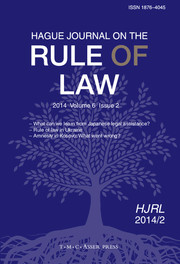Article contents
Rule of Law in Public Administration: Problems and Ways Ahead in Post-Conflict Peace-building
Published online by Cambridge University Press: 17 December 2010
Abstract
This article demonstrates that in many peace-building environments, public administration reform and justice sector reform are promoted as separate projects and underpinned by different paradigms, namely making the administration more effective and efficient while introducing and strengthening rule of law and human rights principles in the justice sector. The reasons for this division include lack of knowledge among international and national policy-makers concerning the relevance of the rule of law for public administration reform, vague and conflicting peace-building mandates and objectives, and differences in topical orientation and ‘culture’ among the international actors concerned. The resulting rule of law deficit in public administration reform has adverse effects on both states and individuals, not least for the protection of fundamental human rights. This deficit is also symptomatic of an even deeper dilemma: the distinction between ends and means in post-conflict efforts.
In order to more closely integrate rule of law dimensions in public administration reform, the article suggests an inventory of possible approaches, and relates these to current and future challenges and needs. The inventory comprises developing concepts of rule of law in public administration, promoting transformation of international rule of law principles to national law, facilitating institutional reforms to ensure the presence of institutions willing and able to adhere to the rule of law; the development of manuals, handbooks and other ‘aids’ for law-makers and administrators; developing tools for monitoring the ‘qualitative’ dimensions of public administration; transparency enhancement to enable individuals to enforce their rights; and improving inter-agency/sector co-operation in order to promote coordination and integrated approaches.
Keywords
- Type
- Notes
- Information
- Copyright
- Copyright © T.M.C. Asser Press and the Authors 2010
- 4
- Cited by




